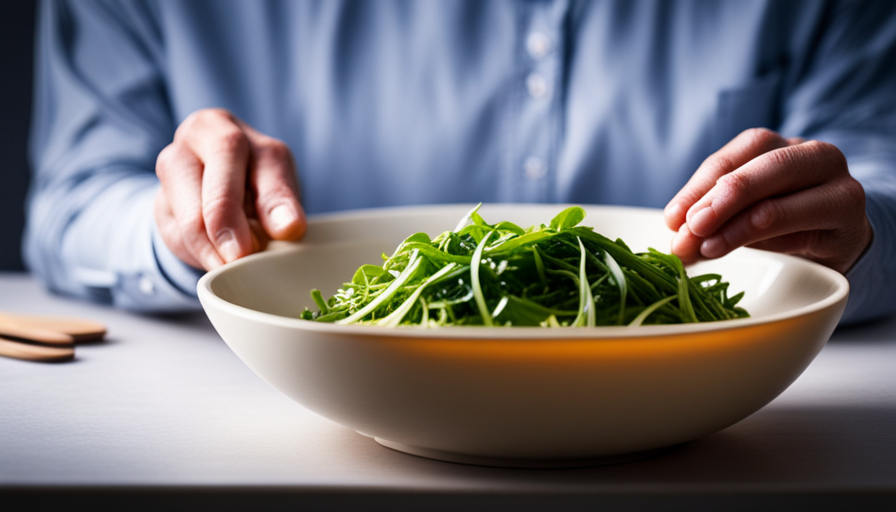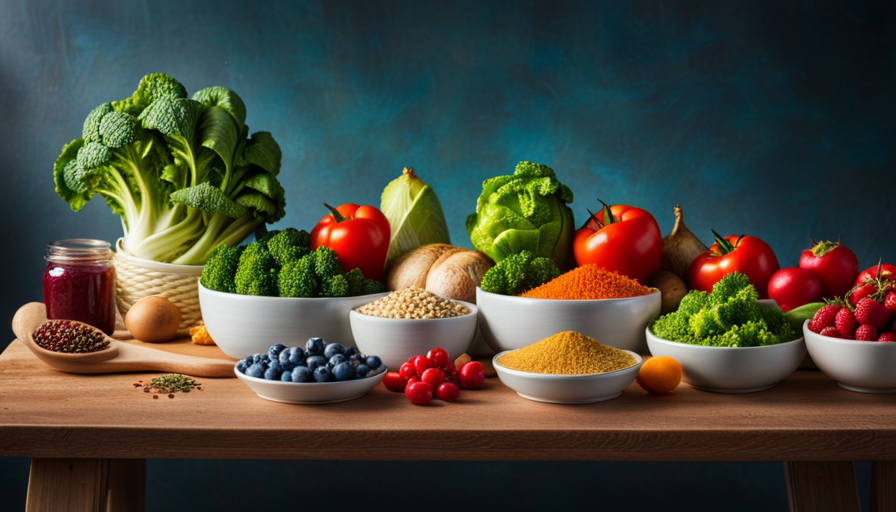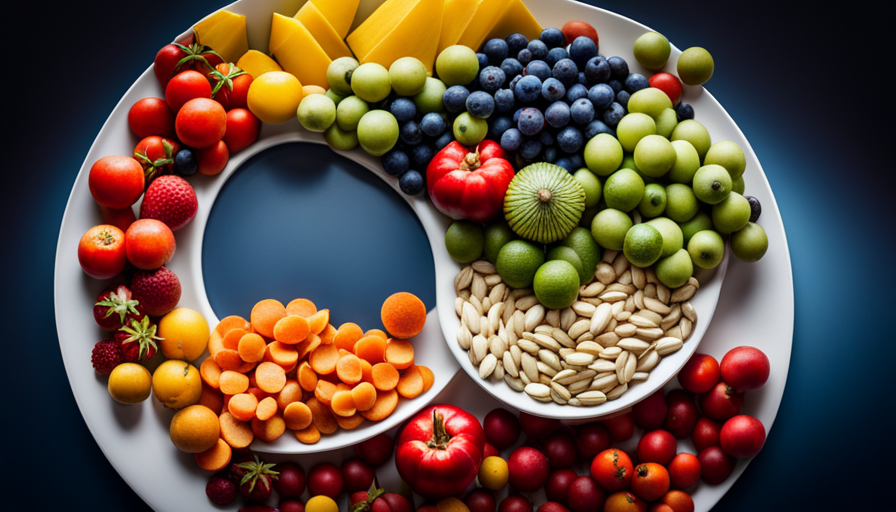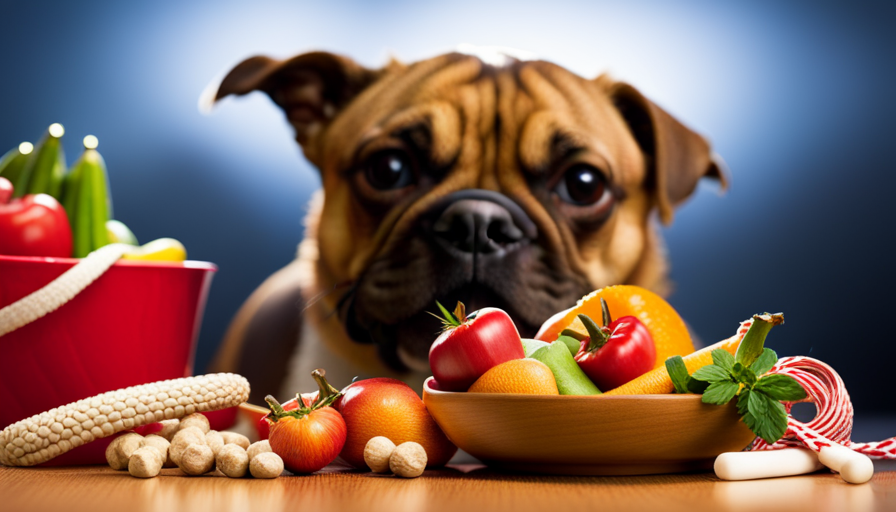Do you want to provide your beloved pet with the optimal nutrition they deserve?
Imagine a world where dogs can thrive on a diet that closely resembles what their ancestors ate. Just like humans benefit from a balanced and wholesome diet, dogs can also experience improved health and vitality with the right food choices.
Raw food, also known as a ‘prey model diet,’ is gaining popularity among dog owners who want to provide their pets with the most natural and nutrient-rich meals. It’s like giving your dog a ticket back to their wild roots, where they can enjoy the benefits of a diet high in protein, healthy fats, and essential nutrients.
In this article, we will explore the benefits of raw food for dogs, guide you on how to introduce it into your dog’s diet, and address common concerns and misconceptions. Prepare to embark on a journey that will transform your dog’s health and well-being.
Key Takeaways
- Raw food closely mimics the natural diet of dogs’ ancestors, wolves.
- Raw food is rich in essential nutrients: vitamins, minerals, and enzymes.
- Dogs on a raw food diet can experience improved digestion, increased energy levels, and a healthier coat.
- Consulting with a veterinarian is important before transitioning to a raw food diet.
Understanding the Benefits of Raw Food for Dogs
You’ll be amazed at the incredible benefits your furry friend will experience when you start feeding them raw food. Understanding the risks of raw food for dogs is essential in making an informed decision about their diet.
Many pet owners are turning to raw food as an alternative diet for their dogs, and for good reason. Raw food provides numerous advantages for dogs.
First and foremost, it closely mimics the natural diet of their ancestors, the wolves. By feeding them raw food, you’re providing them with a diet that’s rich in essential nutrients, including vitamins, minerals, and enzymes. This can lead to improved digestion, increased energy levels, and a healthier coat.
Additionally, raw food can help with weight management. Dogs on a raw food diet tend to maintain a healthy weight more easily, as the food is more nutrient-dense and less calorie-dense compared to processed dog food. This can be especially beneficial for dogs that struggle with weight issues or obesity.
Furthermore, raw food has been linked to a reduced risk of certain health conditions, such as allergies and skin problems. Many dog owners have reported that their pets’ allergies have significantly improved or even disappeared after switching to a raw food diet.
Exploring alternative diets for dogs, such as raw food, can have numerous benefits for your furry friend. However, it’s important to understand the risks and consult with a veterinarian to ensure your dog’s specific needs are met.
Consulting with a Veterinarian
Before taking any action, it’s essential to consult with a veterinarian who can provide valuable guidance on this matter.
When it comes to transitioning your dog to a raw food diet, a veterinarian’s recommendations can be incredibly beneficial. They have the knowledge and expertise to help you make an informed decision and ensure the health and well-being of your furry friend.
A veterinarian can assess your dog’s specific needs and help you determine if a raw food diet is appropriate for them. They can take into account factors such as age, breed, and any existing health conditions. Additionally, they can provide guidance on the proper balance of nutrients and portion sizes to ensure your dog is getting all the necessary vitamins and minerals.
Consulting with a veterinarian is particularly important because there can be potential risks associated with a raw food diet. While many dogs thrive on this type of diet, it’s not suitable for every dog. A veterinarian can help identify any potential health concerns and provide recommendations to mitigate these risks.
Before embarking on a raw food diet for your dog, it’s crucial to consult with a veterinarian. They can offer valuable recommendations and advice based on their expertise, ensuring the health and well-being of your furry companion. Don’t hesitate to seek their guidance to make the best decision for your dog’s nutrition.
Gradually Introducing Raw Food into Your Dog’s Diet
When transitioning to a raw diet, it’s important to slowly introduce your dog to the new food to allow their digestive system to adjust gradually. A gradual transition not only helps prevent digestive upset but also allows your dog to adapt to the new diet more easily.
Here are some tips to help you with this process:
-
Start by mixing a small amount of raw food with your dog’s current diet. Gradually increase the proportion of raw food over several days or weeks, depending on your dog’s tolerance.
-
Monitor your dog closely during the transition period. Look for any signs of digestive upset, such as diarrhea or vomiting. If you notice any issues, slow down the transition or consult with a veterinarian.
-
Pay attention to your dog’s overall health and behavior. A gradual transition should not cause any drastic changes in their energy levels or appetite. If you notice any concerning changes, seek professional advice.
-
Be aware of the potential risks associated with a raw diet, such as bacterial contamination or nutritional imbalances. It’s crucial to source high-quality raw food and properly handle and store it to minimize these risks.
-
Consider working with a veterinarian or a canine nutritionist to ensure a balanced and complete diet for your dog during the transition to raw food.
Remember, a gradual transition is key when introducing raw food into your dog’s diet. By taking it slow and monitoring your dog’s response, you can help ensure a smooth and successful transition to a healthier diet.
Choosing the Right Raw Food Ingredients
To make a successful transition to a raw diet for your dog, it’s crucial to carefully select the right ingredients. Choosing appropriate proteins and incorporating necessary vitamins are key factors in ensuring your dog receives a balanced and nutritious diet. When it comes to proteins, opt for high-quality sources such as chicken, turkey, beef, and fish. These meats are packed with essential amino acids that support your dog’s overall health and well-being. Additionally, include organ meats like liver and kidney, as they are rich in vitamins and minerals.
To ensure your dog receives a well-rounded diet, it’s important to incorporate necessary vitamins. Fruits and vegetables are excellent sources of vitamins and antioxidants. They provide essential nutrients like vitamin C, vitamin A, and fiber. Some suitable options include carrots, spinach, blueberries, and sweet potatoes.
To help you better understand the appropriate proteins and vitamins to include in your dog’s raw food diet, refer to the table below:
| Protein Sources | Vitamin Sources |
|---|---|
| Chicken | Carrots |
| Turkey | Spinach |
| Beef | Blueberries |
| Fish | Sweet Potatoes |
By selecting the right ingredients and incorporating a variety of proteins and necessary vitamins, you can ensure your dog’s raw food diet is both nutritious and delicious.
Preparing and Storing Raw Food Properly
Get ready to unleash your inner chef and whip up some mouthwatering meals for your pup – just make sure you don’t turn your kitchen into a messy disaster zone in the process! When it comes to preparing and storing raw food for your furry friend, there are a few key things to keep in mind.
First and foremost, proper preparation is essential. Start by thoroughly washing your hands and all surfaces that’ll come into contact with the raw food. This helps to prevent the spread of harmful bacteria. Additionally, make sure to use separate cutting boards and utensils for raw meat and other ingredients to avoid cross-contamination.
When it comes to storing raw food, it’s important to keep it at the right temperature. Raw meat should be stored in the refrigerator at or below 40°F to prevent bacterial growth. If you’re not planning on using the food within a few days, it’s best to freeze it. Be sure to package the raw food in airtight containers or freezer bags to maintain its freshness and prevent freezer burn.
Remember to always follow safe food handling practices to ensure the health and well-being of your pup. By properly preparing and storing raw food, you can provide your furry friend with a delicious and nutritious meal.
Monitoring Your Dog’s Health and Adjusting the Diet
Now that you have learned how to properly prepare and store raw food for your dog, it’s time to focus on monitoring their health and adjusting their diet accordingly. One important aspect of feeding a raw diet is being attentive to your dog’s weight and overall well-being.
Monitoring your dog’s weight is crucial in ensuring that they are receiving the right amount of food. Just like humans, dogs can experience weight gain or loss, and it’s important to make adjustments to their meal portions accordingly. By regularly weighing your dog and keeping track of their weight, you can identify any changes and make the necessary adjustments to their diet.
To help you better understand your dog’s weight and dietary needs, I have prepared a table for you to reference. This table will assist you in monitoring their weight gain and adjusting their meal portions accordingly.
| Weight Range (lbs) | Meal Portion (oz) |
|---|---|
| 10-20 | 4-6 |
| 21-30 | 6-8 |
| 31-40 | 8-10 |
| 41-50 | 10-12 |
By referring to this table and regularly monitoring your dog’s weight, you can ensure that their diet is appropriate for their individual needs. Adjusting their meal portions accordingly will help maintain a healthy weight and overall well-being. Remember, always consult with your veterinarian for personalized advice and guidance.
Balancing Nutritional Needs for Optimal Health
Take a moment to understand how to balance your dog’s nutritional needs for optimal health and enjoy the benefits of a well-rounded diet. When feeding your dog a raw food diet, it’s important to ensure they’re receiving all the necessary nutrients.
One way to achieve this is by incorporating nutritional supplements into their meals. Nutritional supplements can help fill any gaps in your dog’s diet and provide them with essential vitamins and minerals. For example, omega-3 fatty acids are beneficial for your dog’s skin, coat, and overall health. You can find these supplements in the form of fish oil or flaxseed oil.
Additionally, it’s crucial to prioritize raw food safety when preparing your dog’s meals. Make sure to handle raw meat with care, keeping it separate from other foods to avoid cross-contamination. Wash your hands thoroughly after handling raw meat and sanitize any surfaces or utensils that come into contact with it.
By balancing your dog’s nutritional needs and practicing raw food safety, you can ensure they’re receiving a well-rounded diet that promotes optimal health. Remember to consult with your veterinarian to determine the specific dietary needs of your dog and to get advice on the best nutritional supplements to incorporate into their meals.
Transitioning from Commercial Dog Food to Raw Food
Making the switch from processed kibble to the delightfully fresh and nourishing world of raw doggy cuisine is like embarking on a culinary adventure that’ll have your pup’s taste buds wagging with excitement.
Transitioning to raw food can greatly benefit your furry friend’s health and vitality. To ensure a smooth transition, here are some helpful tips:
-
Take it slow: Gradually introduce raw food by mixing it with your dog’s current diet. Start with a small amount and gradually increase the ratio of raw food over time.
-
Balance the nutrients: Raw food should provide a well-rounded diet for your dog. Include a variety of proteins, fruits, vegetables, and supplements to meet their nutritional needs.
-
Observe your dog’s reactions: Monitor your pup’s response to the new diet. Look for any signs of digestive issues or allergies and adjust accordingly.
-
Seek guidance: Consult with a veterinarian or a canine nutritionist to ensure you’re meeting your dog’s specific dietary requirements.
When transitioning, it’s important to avoid common mistakes that could hinder your dog’s adjustment. These include abruptly switching diets, overlooking nutrient balance, and not seeking professional guidance.
By following these tips and avoiding common pitfalls, you can successfully transition your dog to a raw food diet and provide them with a healthy and delicious meal experience.
Addressing Common Concerns and Misconceptions
To debunk some common concerns and misconceptions, let’s address the benefits and facts about transitioning your dog to a raw diet.
Many pet owners worry that raw food may contain harmful bacteria, but it’s important to note that dogs have a shorter digestive tract than humans, making them better equipped to handle bacteria. In fact, their stomachs produce more acid, which helps kill any potential pathogens.
Additionally, concerns about nutrient deficiencies can be addressed by ensuring a balanced raw diet that includes a variety of proteins, fruits, and vegetables.
Another misconception is that raw food diets are expensive. While it’s true that some commercially prepared raw food can be pricey, it is possible to provide a raw diet for your dog without breaking the bank. Many pet owners opt to prepare their dog’s meals at home, using affordable cuts of meat and locally sourced produce.
Contrary to popular belief, raw food does not lead to aggressive behavior in dogs. Aggression is a complex issue that is influenced by many factors, such as genetics and environment. Feeding your dog a raw diet will not inherently make them more aggressive.
It’s important to separate fact from fiction when it comes to raw food for dogs. By addressing common misconceptions and debunking myths, we can make informed decisions about what’s best for our furry friends. So, don’t let these misconceptions hold you back from exploring the benefits of a raw diet for your dog.
Providing Variety and Ensuring a Balanced Diet
Ensuring a balanced diet for your dog means incorporating a variety of proteins, fruits, and vegetables, providing them with the nutrition they need for optimal health and wellbeing. When feeding your dog a raw food diet, it’s important to consider portion control and manage any potential food allergies.
To ensure portion control, it’s recommended to feed your dog based on their age, weight, and activity level. It’s important to consult with your veterinarian to determine the appropriate amount of food to feed your dog. Overfeeding can lead to weight gain and other health issues, while underfeeding can result in nutrient deficiencies.
Managing food allergies is another crucial aspect of providing a balanced diet. Some dogs may be allergic to certain proteins or ingredients commonly found in raw food diets. If you suspect your dog has a food allergy, it’s best to consult with your veterinarian to determine the specific allergens and adjust their diet accordingly. This may involve eliminating certain proteins or ingredients from their diet and finding suitable alternatives.
Incorporating variety into your dog’s diet is also essential. Offering different protein sources, such as beef, chicken, turkey, or fish, ensures they receive a wide range of nutrients. Similarly, providing a variety of fruits and vegetables helps to meet their nutritional needs. Remember to introduce new foods gradually to avoid digestive upset.
By ensuring portion control, managing food allergies, and providing a variety of proteins, fruits, and vegetables, you can help ensure a balanced and nutritious raw food diet for your dog. Remember to consult with your veterinarian for personalized advice and guidance.
Frequently Asked Questions
How much raw food should I feed my dog?
Feeding raw food to dogs: Is it safe and healthy? Well, let me break it down for you.
When it comes to your furry friend’s diet, the benefits of raw food are immense. Not only does it provide essential nutrients, but it also promotes healthier skin, a shinier coat, and better dental health.
However, it’s important to consult with your vet to determine the right amount of raw food to feed your dog, as individual needs may vary.
Can I feed my dog raw food if they have specific dietary restrictions or allergies?
Yes, you can feed your dog raw food even if they have specific dietary restrictions or allergies. Feeding raw food to dogs with dietary restrictions can provide several benefits, such as improved digestion and reduced allergies. However, it’s crucial to consult with a veterinarian or a veterinary nutritionist to ensure a balanced diet. There are potential risks associated with feeding raw food, such as bacterial contamination and nutritional imbalances, so it’s important to handle and prepare raw food safely.
Are there any specific safety precautions I should take when handling raw food for my dog?
To safely handle raw food for dogs, there are important precautions to take. First, always wash your hands thoroughly before and after handling raw food. Use separate cutting boards, utensils, and bowls for raw food to avoid cross-contamination. Store raw food properly in the refrigerator or freezer to prevent bacterial growth.
Additionally, clean all surfaces and utensils that come into contact with raw food with hot, soapy water. Following these precautions will help ensure the safety of your dog’s raw diet.
How long can I store raw dog food in the refrigerator before it goes bad?
To store raw dog food in the refrigerator, it’s important to follow best practices for handling raw food. First, make sure the food is properly sealed in an airtight container to prevent contamination. The food should be stored at a temperature below 40°F (4°C) to slow bacterial growth.
Generally, raw dog food can be safely stored in the refrigerator for up to 3-5 days. However, it’s always recommended to check for any signs of spoilage, such as a foul odor or mold, before feeding it to your dog.
Can I mix raw food with commercial dog food in my dog’s diet?
Yes, you can mix raw food with commercial dog food in your dog’s diet. Mixing raw food with commercial dog food can provide a balanced and nutritious diet for your furry friend. Adding raw food to your dog’s diet can offer benefits such as improved digestion, healthier skin and coat, and increased energy levels. However, it’s essential to consult with your veterinarian to ensure you’re providing the right balance of nutrients for your dog’s specific needs.
Can PDD be used as a base for making raw food soup?
Yes, PDD can be used as a base for making raw food soup. This raw food soup recipe is a great way to enjoy a healthy and refreshing meal. Simply blend the PDD with fresh vegetables and herbs to create a delicious and nutritious soup that is perfect for any occasion.
Conclusion
In conclusion, incorporating raw food into your dog’s diet can have numerous benefits for their overall health and well-being. By consulting with a veterinarian and gradually introducing raw food, you can provide a balanced and nutritious diet for your furry friend. It is important to choose the right ingredients and ensure proper preparation and storage to ensure food safety. Transitioning from commercial dog food to raw food may require some adjustments, but addressing concerns and misconceptions will help ease the process. Remember, variety is key to keeping your dog’s meals interesting and ensuring they receive all the necessary nutrients.
So, don’t let the cat out of the bag – give your dog the raw deal they deserve!










